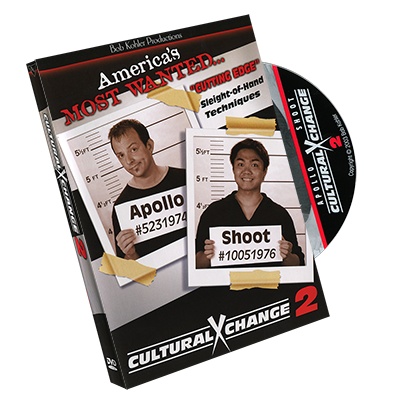Cultural XChange 2
Apollo Robbins; Shoot Ogawa
Bob Kohler Productions
(Based on 2 reviews)

Reviews
(Top ▲)
I have to agree with David on some of the points he makes about the restrictions of the material on this DVD. It will not suit every performance style or venue, but if you have use your imagination, most of the routines on here can be changed so that they work for you and/or a specific venue in a way that is better than they are presented here. I will say that if you read my review of the first Cultural Xchange DVD, I mentioned that the first DVD could have benefitted from a tad more clarity in some of the routines. That is not the case here - everything seemed to be very clearly explained. As with the first volume, Cultural Xchange, the material presented here was meant for use in situations where it is too loud for you to talk or speak.
One of my all-time favorite Greg Wilson effects, Recap, was expanded upon on this disc by Apollo. In this handling, it requires an extra pen and if you present it the way Apollo does, there are some angle restrictions. I love his ideas and additions to the effect and have changed a few of them around so that they still look the same, but the angle restrictions have either shrunk or disappeared. Very magical routine.
The Coins to Glass was very clean and looks quite magical - one of my favorites from this volume. It plays well but it does have a few angle issues that can be solved through routining as the venue/audience positioning requires. As it is taught on this disc, this one will require a table.
I am a big fan of matrix-style effects (many magicians are not), so I really enjoyed the Impossible Change, the No Steal Matrix and Quick Matrix from Shoot Ogawa. They were very well executed but are only suitable to table work. These routines caught me off guard and they did fool me. I will definitely use these in my formal parlor show and some of my trade shows.
Kelly in the Box and Kelly Cuts the Aces look great, but it is my opinion also that Kelly Cuts the Aces is a bit awkward looking in the way that the magician always handles the cards and in the way the cuts are made. I will have to say, I LOVE the mechanics of Kelly Cuts the Aces and I think it has a lot of potential in other effects/routines. For this particular handling and use, if you can keep the mechanics the same but change the way you (as the magician) makes the cuts, it has a lot of promise. As it stands, I think a better title would be something like "Spectator/Kelly 'Calls' the Aces" or something to that effect.
Kelly in the Box is a great handling of a signed card to the box, but this handling is quite angle-intensive and better done for a group of three or four people at a time. This routine and its handling are based on the R. Kelly Concept and an idea for getting the card into the box from Paul Gertner.
Perp to Pocket is an effect that has the potential to be very magical, but as it is presented here, it suffers from the lack of 'time misdirection'. As Mr. Acer points out in his review, the 'move' to pull the card out of the pocket is done at the worst possible time in the routine. This would make a nice 'impromptu card to pocket/wallet' type of effect if you ever find yourself without your, ahem, wallet. Again, time misdirection is needed and essential, in my opinion. Overall, it is a great idea and concept that I would like to play around with myself.
Apollo shares his Heel Tap, which I think is a great little gem. It is very restrictive in that you can really only play to a head-on audience of no more than two or three people, but there is an easy way to clean this one up if you think about it. The possibilities of this change/transformation are limited only by your imagination, as Apollo points out on the DVD. This is a great thing to use if you were to borrow and object and make it vanish, only to reappear via transformation at a later time.
I have never been much of a card worker because I always thought cards are overdone and ubiquitous. In recent years I started putting more card work into my acts, but they are things that suit my taste and style, and that get a great reaction with audiences - time tested material. The Great Triumph is a very magical version of this plot, and it surprised the heck out of me with the ending!
Gambler's Transpo is another variation of the Royal Transpo from the first Cultural Xchange DVD, but still different enough. I like this one better, but it requires a table and does have that one moment of angle restrictions right at the very end. This is still a nice little routine and very doable.
8 Way Change is an 8 color change routine used to reveal two selected cards. I like the way Mr. Acer described it: A Mickey Mouse Mathematical routine - the cards change in a numerical sequence. There are some standard color changes used in this one. Even so, some of them look very clean and very magical. My favorite is the part where a 3 of clubs changes into the 6 of clubs, and the 6 changes into the 9 of clubs. That part is done with open fingers and looks like you are moving pips from one part of the card to another and causing more pips to appear in order to change it; the final change it looks as if it changes as you rotate the card underneath the thumb. I am not so sure I would use this routine as taught, but the techniques used for some of the changes I will definitely put into my repertoire where applicable.
The Tip Flip is another item that I would never use as an actual performance piece, but rather more for a dexterity and technique exercise.
Trapeze Trio is one of my favorite routines from this DVD. It looks good, the angles are great when performed up close and is great for walkaround performers. I love the ideas and the routining used here by Apollo - very nice and a little different from your usual 3 Fly/Coins Across actions and handlings.
2B Gone is a great handling of a production and subsequent vanish of two coins. I like the things that you can do with this routine but it has many angle restrictions and is best performed head-on for no more than a group of 4-6 people, unless you can change some of the sleights to eliminate some of the angle problems. Even with that, this is still a great little routine, and in my opinion I think the Shoot Ogawa handling (the second version offered) is the better of the two - though each version taught is for its own specific type of venue. Apollo teaches a stand-up/walkaround version and Shoot teaches his close-up version.
Again, this DVD is not for everyone but with a little bit of imagination, most anyone can make use of some of the material on this volume. As before, if you enjoy the work of Apollo Robbins and Shoot Ogawa, you will still enjoy this DVD even if you do not use anything from it.
Dr. J.
One of my all-time favorite Greg Wilson effects, Recap, was expanded upon on this disc by Apollo. In this handling, it requires an extra pen and if you present it the way Apollo does, there are some angle restrictions. I love his ideas and additions to the effect and have changed a few of them around so that they still look the same, but the angle restrictions have either shrunk or disappeared. Very magical routine.
The Coins to Glass was very clean and looks quite magical - one of my favorites from this volume. It plays well but it does have a few angle issues that can be solved through routining as the venue/audience positioning requires. As it is taught on this disc, this one will require a table.
I am a big fan of matrix-style effects (many magicians are not), so I really enjoyed the Impossible Change, the No Steal Matrix and Quick Matrix from Shoot Ogawa. They were very well executed but are only suitable to table work. These routines caught me off guard and they did fool me. I will definitely use these in my formal parlor show and some of my trade shows.
Kelly in the Box and Kelly Cuts the Aces look great, but it is my opinion also that Kelly Cuts the Aces is a bit awkward looking in the way that the magician always handles the cards and in the way the cuts are made. I will have to say, I LOVE the mechanics of Kelly Cuts the Aces and I think it has a lot of potential in other effects/routines. For this particular handling and use, if you can keep the mechanics the same but change the way you (as the magician) makes the cuts, it has a lot of promise. As it stands, I think a better title would be something like "Spectator/Kelly 'Calls' the Aces" or something to that effect.
Kelly in the Box is a great handling of a signed card to the box, but this handling is quite angle-intensive and better done for a group of three or four people at a time. This routine and its handling are based on the R. Kelly Concept and an idea for getting the card into the box from Paul Gertner.
Perp to Pocket is an effect that has the potential to be very magical, but as it is presented here, it suffers from the lack of 'time misdirection'. As Mr. Acer points out in his review, the 'move' to pull the card out of the pocket is done at the worst possible time in the routine. This would make a nice 'impromptu card to pocket/wallet' type of effect if you ever find yourself without your, ahem, wallet. Again, time misdirection is needed and essential, in my opinion. Overall, it is a great idea and concept that I would like to play around with myself.
Apollo shares his Heel Tap, which I think is a great little gem. It is very restrictive in that you can really only play to a head-on audience of no more than two or three people, but there is an easy way to clean this one up if you think about it. The possibilities of this change/transformation are limited only by your imagination, as Apollo points out on the DVD. This is a great thing to use if you were to borrow and object and make it vanish, only to reappear via transformation at a later time.
I have never been much of a card worker because I always thought cards are overdone and ubiquitous. In recent years I started putting more card work into my acts, but they are things that suit my taste and style, and that get a great reaction with audiences - time tested material. The Great Triumph is a very magical version of this plot, and it surprised the heck out of me with the ending!
Gambler's Transpo is another variation of the Royal Transpo from the first Cultural Xchange DVD, but still different enough. I like this one better, but it requires a table and does have that one moment of angle restrictions right at the very end. This is still a nice little routine and very doable.
8 Way Change is an 8 color change routine used to reveal two selected cards. I like the way Mr. Acer described it: A Mickey Mouse Mathematical routine - the cards change in a numerical sequence. There are some standard color changes used in this one. Even so, some of them look very clean and very magical. My favorite is the part where a 3 of clubs changes into the 6 of clubs, and the 6 changes into the 9 of clubs. That part is done with open fingers and looks like you are moving pips from one part of the card to another and causing more pips to appear in order to change it; the final change it looks as if it changes as you rotate the card underneath the thumb. I am not so sure I would use this routine as taught, but the techniques used for some of the changes I will definitely put into my repertoire where applicable.
The Tip Flip is another item that I would never use as an actual performance piece, but rather more for a dexterity and technique exercise.
Trapeze Trio is one of my favorite routines from this DVD. It looks good, the angles are great when performed up close and is great for walkaround performers. I love the ideas and the routining used here by Apollo - very nice and a little different from your usual 3 Fly/Coins Across actions and handlings.
2B Gone is a great handling of a production and subsequent vanish of two coins. I like the things that you can do with this routine but it has many angle restrictions and is best performed head-on for no more than a group of 4-6 people, unless you can change some of the sleights to eliminate some of the angle problems. Even with that, this is still a great little routine, and in my opinion I think the Shoot Ogawa handling (the second version offered) is the better of the two - though each version taught is for its own specific type of venue. Apollo teaches a stand-up/walkaround version and Shoot teaches his close-up version.
Again, this DVD is not for everyone but with a little bit of imagination, most anyone can make use of some of the material on this volume. As before, if you enjoy the work of Apollo Robbins and Shoot Ogawa, you will still enjoy this DVD even if you do not use anything from it.
Dr. J.
(Top ▲)
I often make the mistake of expecting from a DVD the same sense of fulfillment and satisfaction I receive from books. As a result, I am frequently disappointed at the end of a program, even when there was nothing really lacking in its content.
It is for precisely this reason that I watched Cultural Xchange II three times before putting pen to paper (or rather fingers to keyboard) to write this review, and I'm glad I did. As a result, I was able to subordinate my general skepticism about the medium and make a distinction between material that may not be of much use to me and material that is actually useless.
Shoot Ogawa and Apollo Robbins are two talented, personable young magicians with severely advanced chops. They are creative and, as far as one can tell from just under two hours of edited footage, extremely passionate about magic. This DVD, a follow-up to their 2002 release, Cultural Xchange, contains 16 routines with cards, coins and miscellaneous objects. Every item is executed to perfection, and you will likely be fooled more than once.
However, much of what is on here is simply unusable for the bare-bones conditions in which I usually perform (i.e. no table, surrounded, lots of movement on all sides). I will grant, though, that many of you may have broader opportunities than I in this regard, so maybe my concerns would be a non-issue. For example, Shoot's lovely Impossible Change has four coins from different countries becoming four half-dollars, but it requires table-space and, if not a close-up pad, at least a soft surface. Similarly, his No Steal Matrix and Quick Matrix are beautiful to watch (both of them fooled me), but ultimately, other than TV and The Magic Castle, where can one do them?
Apollo's Heel Tap is a very pretty change of just about any small object that can be palmed into any other small object at the fingertips (coins, dice, keys, whatever). However, it is angly, and must be performed one-on-one. Similarly, both versions of 2B Gone offer extremely magical productions and vanishes of two coins, but again, there are angle issues, and of course, a pressing question of how to engender the trick with emotional hook.
Somewhat more practical (given the conditions I've already described) are Gambler's Transpo, a very clean transposition of four Aces and four Kings; Son Of Recap, Apollo's extended version of Greg Wilson's Recap; and Trapeze Trio, a three-coins-across routine, but even these make use of a gambler's cop, multiple loads behind the ear, and back-clips respectively, all of which are angle intensive. Indeed, only 2 of the 16 routines on this DVD do not have angle restrictions - Great Triumph and 8 Way Change - though for Impossible Change and the matrix effects, you have only to keep people from standing behind you.
Finally, there are a few routines on here that, regardless of performing conditions, I'm not so enamored with. Kelly Cuts Aces is a Spectator-Cuts-To-The-Aces that isn't. In other words, the magician handles the cards at all times, asking a spectator to call "stop" as he executes a series of in-the-hands cuts, until four packets have been laid face down on the table. I find the cutting sequence here looks awkward, and ultimately, the plot is stronger if the spectator can cut the deck into four piles himself (see Randy Wakeman's The Spectator Cuts To And Turns Over The Aces in Formula One Close-Up for what many consider to be the benchmark of the genre).
Great Triumph is a multi-phase Triumph routine that would no doubt fool anyone who saw it, but I'm not convinced it's any stronger from a laymen's perspective than the classic approach.
Perp to Pocket is a signed-card-to-pocket that involves a steal of the selection from a packet of Aces that must be executed at precisely the worst possible moment (i.e. just after the card is shown to have vanished from the packet using the Ascanio Spread).
In addition, there is a one-coin routine (Tip Flip), a card-to-card-case (Kelly In The Box), a Mickey-Mouse-Math type effect (8 Way Change), and a lovely routine in which four coins penetrate a drinking glass one by one (a highlight of the video).
So where does that leave us? Well, Shoot & Apollo deliver exactly what they promise -- this DVD is full of well-executed, magical routines -- but whether or not they will be usable given your usual performing conditions is something you'll have to decide for yourself.
David Acer
It is for precisely this reason that I watched Cultural Xchange II three times before putting pen to paper (or rather fingers to keyboard) to write this review, and I'm glad I did. As a result, I was able to subordinate my general skepticism about the medium and make a distinction between material that may not be of much use to me and material that is actually useless.
Shoot Ogawa and Apollo Robbins are two talented, personable young magicians with severely advanced chops. They are creative and, as far as one can tell from just under two hours of edited footage, extremely passionate about magic. This DVD, a follow-up to their 2002 release, Cultural Xchange, contains 16 routines with cards, coins and miscellaneous objects. Every item is executed to perfection, and you will likely be fooled more than once.
However, much of what is on here is simply unusable for the bare-bones conditions in which I usually perform (i.e. no table, surrounded, lots of movement on all sides). I will grant, though, that many of you may have broader opportunities than I in this regard, so maybe my concerns would be a non-issue. For example, Shoot's lovely Impossible Change has four coins from different countries becoming four half-dollars, but it requires table-space and, if not a close-up pad, at least a soft surface. Similarly, his No Steal Matrix and Quick Matrix are beautiful to watch (both of them fooled me), but ultimately, other than TV and The Magic Castle, where can one do them?
Apollo's Heel Tap is a very pretty change of just about any small object that can be palmed into any other small object at the fingertips (coins, dice, keys, whatever). However, it is angly, and must be performed one-on-one. Similarly, both versions of 2B Gone offer extremely magical productions and vanishes of two coins, but again, there are angle issues, and of course, a pressing question of how to engender the trick with emotional hook.
Somewhat more practical (given the conditions I've already described) are Gambler's Transpo, a very clean transposition of four Aces and four Kings; Son Of Recap, Apollo's extended version of Greg Wilson's Recap; and Trapeze Trio, a three-coins-across routine, but even these make use of a gambler's cop, multiple loads behind the ear, and back-clips respectively, all of which are angle intensive. Indeed, only 2 of the 16 routines on this DVD do not have angle restrictions - Great Triumph and 8 Way Change - though for Impossible Change and the matrix effects, you have only to keep people from standing behind you.
Finally, there are a few routines on here that, regardless of performing conditions, I'm not so enamored with. Kelly Cuts Aces is a Spectator-Cuts-To-The-Aces that isn't. In other words, the magician handles the cards at all times, asking a spectator to call "stop" as he executes a series of in-the-hands cuts, until four packets have been laid face down on the table. I find the cutting sequence here looks awkward, and ultimately, the plot is stronger if the spectator can cut the deck into four piles himself (see Randy Wakeman's The Spectator Cuts To And Turns Over The Aces in Formula One Close-Up for what many consider to be the benchmark of the genre).
Great Triumph is a multi-phase Triumph routine that would no doubt fool anyone who saw it, but I'm not convinced it's any stronger from a laymen's perspective than the classic approach.
Perp to Pocket is a signed-card-to-pocket that involves a steal of the selection from a packet of Aces that must be executed at precisely the worst possible moment (i.e. just after the card is shown to have vanished from the packet using the Ascanio Spread).
In addition, there is a one-coin routine (Tip Flip), a card-to-card-case (Kelly In The Box), a Mickey-Mouse-Math type effect (8 Way Change), and a lovely routine in which four coins penetrate a drinking glass one by one (a highlight of the video).
So where does that leave us? Well, Shoot & Apollo deliver exactly what they promise -- this DVD is full of well-executed, magical routines -- but whether or not they will be usable given your usual performing conditions is something you'll have to decide for yourself.
David Acer





